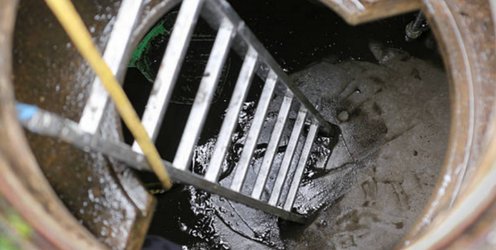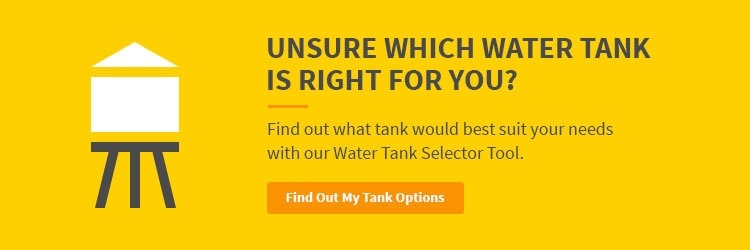Keeping your water tank clean inside is especially necessary if you are using the water for drinking. Apart from health issues, clean tanks also save on filter cleaning or replacing, and water pump failures. Sludge is a common problem for water tanks, however there are things you can do to minimise it, work around it, or remove it. Read on to learn more about sludge and what you can do about it.
Download this Free Report

What is sludge?
Sometimes, even if you have a strainer installed, organic material can build up at the bottom of your water tank. Plant material, sediment, and other waste will sink to the bottom and begin to decay, creating a layer of thick sludge. This sludge is most often from impurities, such as dirt, leaves, paint flakes, insects, etc., and are not strictly a health issue. However, it can create problems for filters and pumps on appliances.
While your water tank normally contains many varieties of bacteria which are not harmful, there are some varieties that can cause health problems.
As this sludge contaminates your water, it can become the perfect environment for harmful bacteria to breed, such as E-coli and Campylobacter. This bacteria needs to be monitored or filtered out as it can make you or members of your family ill.
What can I do to reduce sludge in my tank?
Prevention is better than cure when considering sludge in a tank. To reduce sludge, you first need to consider where it comes from.
If you are collecting water from a roof this means that the water runoff will bring any dust that has settled on the roof and will wash in any bird droppings or from any rodent or animal that climbs on a roof. Also contributing to sludge in your tank are leaves, debris or paint flakes or even insects.
Without taking some measures of prevention, it's almost guaranteed that your tank will build up a layer of sludge on the bottom of the tank. Simple steps such as removing overhanging branches from your roof, removing access to your roof for animals and keeping your gutters clean will be the best start to reducing the amount of sludge building up.
Other steps to take include fitting leaf diverters to down-pipes or leaf guard to guttering. Cover the inlet and overflow of your tank with a mesh to prevent birds, animals and insects from gaining direct access to the water.
Having two tanks gives you a further advantage as it allows you to have a settling tank system. This means that you use the tanks in a series whereby the first tank takes the first rains allowing any sediment to settle to the bottom of this tank. The water from the first tank then needs to flow or be pumped to the second tank; however, do not draw the water from the base of the first tank. The bottom of the first tank will be where the sludge will settle.
If using a pump, a floating inlet draws the best quality water from 200mm below the water surface which also prevents the pump drawing a free surface vortex that could easily ingest air into the pump.
Having two water tanks means that most of the sludge will be in the first tank meaning only one tank to clean. The first tank would be more suited for garden use, while the second will be better for washing machines and drinking.
Can I clean out sludge by hand?
Cleaning out a tank by hand is possible, but can also be a time-consuming job. You can drain the water from the tank, hose it out, and sweep out the bottom. This way, you can be sure you get all the sludge, but emptying out the tank and climbing into it can be dangerous or difficult.
You could also get a rainwater tank pump for cleaning, which will suck the sludge out. However, this can be a big cost if you are only cleaning your tank every few years. Many times, it just makes sense to pay a company to clean your tank, although this too, can be costly.
Related topic:
Water Tanks Cost and Pricing Guide
Remember that the inside of a tank is a confined space with little ventilation. See that you practice safety working in such confined spaces. If you need to clean your tank, consider using a professional tank cleaning service to stay safe.
What is a water tank self-cleaning system?
Another option is a self-cleaning system, such as a tankvac, which automatically cleans out any waste or contaminants as soon as they enter the water. Once you install such a system, you don't have to worry about it again, so you don't have to constantly be cleaning your tank or worrying about contamination.
When installing a self-cleaning system, you put a special pipe at the bottom of your tank which creates a vacuum that sucks out poor quality wastewater and harmful sludge.
How do I know if the sludge in my tank is harmful?
You should inspect your external roof, gutter and tank every 6 months or less. It is also good practice to inspect inside your tank every 2-3 years and clean out any sludge that may have built up.
Over time you can build up a low level of immunity to some microbes. If your tank isn't cleaned regularly, you can get to a level where it becomes an enormous health hazard. People experience diarrhea, vomiting, stomach cramps, cold sweats, dehydration and even death.
Water testing can give you some indication of the state of your water but only at the time it was taken. The quality of the water can change rapidly with temperature, rainfall frequency and the seasonal behaviour of birds and animals.
Microbes & bacteria multiply in water by splitting themselves in half. Depending on the temperature and the species this process can take as little as 20 minutes. This will make the water smell which is the gas given off by bacteria. The water may also thicken which is caused by their huge numbers as the bacteria rapidly multiplies.
If contamination is found or suspected, then remove the contamination and disinfect your tank water with an appropriate dose of non-stabilised chlorine (about 5 milligrams per litre). Chlorine testing should be performed with an appropriate kit.
When using your water tank for drinking,the safest thing you can do is install a filtration system between your tank and your drinking tap. The appropriate filtration system will prevent any contamination or bacteria that you may miss between inspections.
For more tips on water tanks, contact us today.
This article is meant to provide helpful information on the topic discussed. It is not meant to replace recommendations made by a qualified practitioner.









What do you think about this post?
Comments